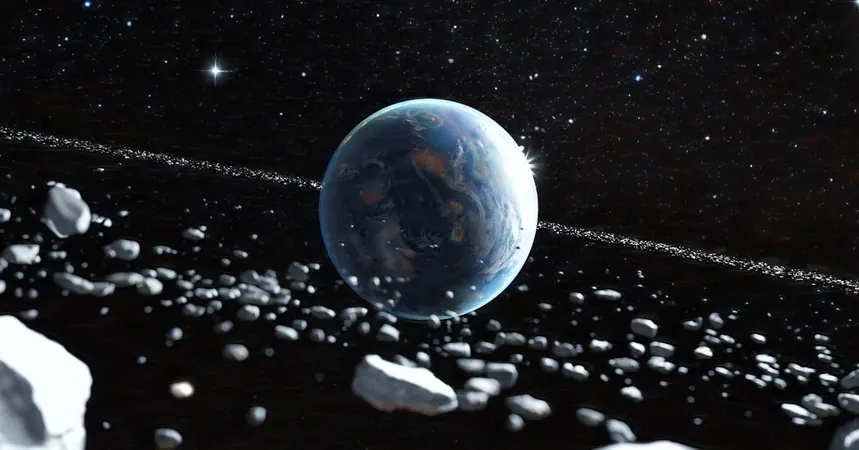
Did Earth Have a Floating Ring 466 Million Years Ago? The Shocking Findings from Recent Research!
2024-09-24
Introduction
Imagine gazing up at the night sky 466 million years ago and being dazzled by a magnificent ring encircling our planet. According to groundbreaking research published recently, that might not just be a figment of our imagination!
The Ordovician Meteor Event
This recent study explores a remarkable uptick in impact craters during the Ordovician Period—an era when land animals were virtually nonexistent. Researchers propose that this surge in meteorite activity could be linked to an ancient ring composed of asteroid debris that orbited Earth for an extensive period.
For centuries, scientists have debated the origins of the Ordovician meteor event, which saw Earth being showered with celestial rocks at an alarming rate, leading to the formation of numerous craters. While earlier theories suggested that this onslaught resulted from a large asteroid fragmenting in the main belt between Mars and Jupiter, new insights point to a more alarming scenario.
The Research Team's Findings
Led by Andy Tomkins, a professor of Earth and planetary sciences at Monash University in Australia, this study introduces the theory that a rogue asteroid may have ventured dangerously close to Earth—within thousands of miles—and was subsequently torn apart by our planet’s gravitational pull. The remnants then supposedly formed a ring around the Equator, coinciding with major shifts in climate and biodiversity.
Dr. Tomkins drew inspiration from an article discussing the formation of Mars' moons, Phobos and Deimos, which originated from debris of a ring around the Red Planet. This prompted him to investigate how Earth’s geological record might reveal signs of a similar phenomenon.
Craters and Geographical Concentration
Analyzing the locations of 21 craters from the Ordovician, the research team discovered an intriguing pattern. Instead of being randomly scattered, these craters were predominantly clustered near the Equator—a strong indicator that they were the result of meteorites originating from an equatorial ring. "That’s what gave it away," Dr. Tomkins noted, highlighting the geographical concentration of the craters as distinctive.
Mars and the Moon's Findings
Interestingly, the researchers found no evidence suggesting that Mars or its moon experienced similar patterns of impact cratering during this time. This fact proposes the possibility that the debris was uniquely localized to Earth. Moreover, they examined Ordovician meteorites from Sweden that demonstrated low exposure to cosmic radiation, implying these rocks fell to Earth shortly after their parent body disintegration—contrasting with typical asteroid belt debris, which can be exposed for millions of years.
Impact on Climate
In a twist, the team even speculated that the shadow cast by the ring could have contributed to a global climate shift, potentially leading to the Hirnantian ice age—a dramatic event that altered the path of life on Earth. While Dr. Tomkins acknowledges this connection as speculative, he argues it's worthy of exploration.
Community Perspectives
This intriguing hypothesis has elicited varying perspectives from the scientific community. Birger Schmitz, a professor of geology at Lund University in Sweden, praised the innovative approach of the research but emphasized the need for additional data. "This new perspective will undoubtedly advance our understanding of the Ordovician period," he remarked.
Conversely, Gretchen Benedix, from Curtin University, expressed some skepticism regarding the proposed link to the Hirnantian ice age and highlighted that meteorite impacts could occur far from the equator without leaving discernible traces. "While there are many interesting hypotheticals, the physics and chemistry require further examination," she concluded.
Conclusion
As scientists continue to peel back the layers of our planet's ancient history, these revelations spark both intrigue and skepticism. Was Earth really adorned with a celestial ring? The debate has only just begun! Stay tuned as further research could unveil even deeper mysteries hidden within our planet's past!



 Brasil (PT)
Brasil (PT)
 Canada (EN)
Canada (EN)
 Chile (ES)
Chile (ES)
 España (ES)
España (ES)
 France (FR)
France (FR)
 Hong Kong (EN)
Hong Kong (EN)
 Italia (IT)
Italia (IT)
 日本 (JA)
日本 (JA)
 Magyarország (HU)
Magyarország (HU)
 Norge (NO)
Norge (NO)
 Polska (PL)
Polska (PL)
 Schweiz (DE)
Schweiz (DE)
 Singapore (EN)
Singapore (EN)
 Sverige (SV)
Sverige (SV)
 Suomi (FI)
Suomi (FI)
 Türkiye (TR)
Türkiye (TR)